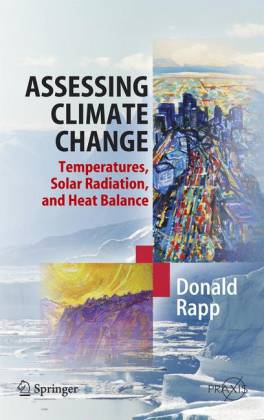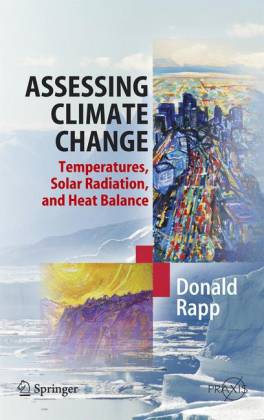
- Afhalen na 1 uur in een winkel met voorraad
- Gratis thuislevering in België vanaf € 30
- Ruim aanbod met 7 miljoen producten
- Afhalen na 1 uur in een winkel met voorraad
- Gratis thuislevering in België vanaf € 30
- Ruim aanbod met 7 miljoen producten
Zoeken
€ 137,45
+ 274 punten
Uitvoering
Omschrijving
In this book Donald Rapp provides a balanced assessment of global warming, tending neither to the views of alarmists or nay-sayers. Rapp has the ability to move into a highly technical field, assimilate the content, organize the knowledge base and succinctly describe the field, its content, its unresolved issues and achievements. This is precisely what he does in this book in relation to global climate change. As such his approach is refreshingly different. Despite the inadequacies of the temperature measurement network, there is little doubt that much of the Earth has been undergoing a moderate warming since about the start of the 20th century, although this warming has been more pronounced in some areas, and it wavered in mid-century. A critical question facing mankind is: Has this global warming been primarily due to natural fluctuations (e.g. increases in total solar irradiance (TSI) coupled to positive feedback effects, changes in ocean heat transport flows, or other variations) or anthropogenic impacts (primarily greenhouse gas production)?
Global warming alarmists believe that the increases in 20th century temperatures are mainly due to increases in greenhouse gases and offer the "hockey stick" picture of global temperature history as evidence of the uniqueness of the 20th century. Nay-sayers dispute these predictions, claiming that the recent rise in temperature has significant regional exceptions, and is likely to be just another in a series of natural fluctuations in climate, not associated with greenhouse gases. They place little faith in climate models, and claim that the "hockey stick" picture of global temperature history is a "fraud" approaching the dimensions of cold fusion.
Published books on global warming and climate change tend to reflect the views of either the alarmists or the nay-sayers. They often start with the conclusion and then attempt to build the case by selecting or analyzing the data to support their thesis, e.g. global warming as a great threat or global warming as a fiction. In this book Donald Rapp attempts to assess the evidence in an objective way. Although he is not a climate scientist by profession, very few climate scientists have taken a broad systems view of the problem of global warming. Donald Rapp is a professional systems engineer, having taught in universities for 14 years and with over 25 years experience managing various programs for NASA. His experience has required the ability to move into a highly technical field, assimilate the content, organize the knowledge base and succinctly describe the field, its content, its unresolved issues and achievements. This is precisely what Donald Rapp does in this book in relation to global climate change. As such his approach is refreshingly different. In ASSESSING CLIMATE CHANGE Donald Rapp has investigated a large body of scientific data relevant to climate change, approaching each element with necessary (but neutral) scientific skepticism. The chapters of the book attempt to answer a number of essential questions in relation to global warming and climate change. He begins by showing how the earth s climate has varied in the past, discussing ice ages, the Holocene period since the end of the last ice age, particularly during the past 1000 years. He investigates the reliability of "proxies" for historical temperatures and assesses the hockey stick version of global temperatures for the past millennium. To do this effectively he looks carefully at how well near surface temperatures of land and ocean on earth have been monitored during the past 100 years or more, and looks at the utility and significance of a single global average temperature.
Topics such as the variability of the Sun and the Earth s heat balance are discussed in considerable detail. The author also investigates how the current global warming trend compares with past fluctuations in earth s climate and what is the likelihood that the warming trend we are experiencing now is primarily just another in a series of natural climate fluctuations as opposed to a direct result of human activities. A key factor in understanding what may happen in the future is to examine the credibility of the global climate models which claim that greenhouse gasses produce most of the temperature rise of the 20th Century, and forecast much greater impacts in the century ahead.
Finally, the book considers future global energy requirements, fossil fuel usage and carbon dioxide production, public policy relating to global warming, and agreements such as the Kyoto Protocol.
Global warming alarmists believe that the increases in 20th century temperatures are mainly due to increases in greenhouse gases and offer the "hockey stick" picture of global temperature history as evidence of the uniqueness of the 20th century. Nay-sayers dispute these predictions, claiming that the recent rise in temperature has significant regional exceptions, and is likely to be just another in a series of natural fluctuations in climate, not associated with greenhouse gases. They place little faith in climate models, and claim that the "hockey stick" picture of global temperature history is a "fraud" approaching the dimensions of cold fusion.
Published books on global warming and climate change tend to reflect the views of either the alarmists or the nay-sayers. They often start with the conclusion and then attempt to build the case by selecting or analyzing the data to support their thesis, e.g. global warming as a great threat or global warming as a fiction. In this book Donald Rapp attempts to assess the evidence in an objective way. Although he is not a climate scientist by profession, very few climate scientists have taken a broad systems view of the problem of global warming. Donald Rapp is a professional systems engineer, having taught in universities for 14 years and with over 25 years experience managing various programs for NASA. His experience has required the ability to move into a highly technical field, assimilate the content, organize the knowledge base and succinctly describe the field, its content, its unresolved issues and achievements. This is precisely what Donald Rapp does in this book in relation to global climate change. As such his approach is refreshingly different. In ASSESSING CLIMATE CHANGE Donald Rapp has investigated a large body of scientific data relevant to climate change, approaching each element with necessary (but neutral) scientific skepticism. The chapters of the book attempt to answer a number of essential questions in relation to global warming and climate change. He begins by showing how the earth s climate has varied in the past, discussing ice ages, the Holocene period since the end of the last ice age, particularly during the past 1000 years. He investigates the reliability of "proxies" for historical temperatures and assesses the hockey stick version of global temperatures for the past millennium. To do this effectively he looks carefully at how well near surface temperatures of land and ocean on earth have been monitored during the past 100 years or more, and looks at the utility and significance of a single global average temperature.
Topics such as the variability of the Sun and the Earth s heat balance are discussed in considerable detail. The author also investigates how the current global warming trend compares with past fluctuations in earth s climate and what is the likelihood that the warming trend we are experiencing now is primarily just another in a series of natural climate fluctuations as opposed to a direct result of human activities. A key factor in understanding what may happen in the future is to examine the credibility of the global climate models which claim that greenhouse gasses produce most of the temperature rise of the 20th Century, and forecast much greater impacts in the century ahead.
Finally, the book considers future global energy requirements, fossil fuel usage and carbon dioxide production, public policy relating to global warming, and agreements such as the Kyoto Protocol.
Specificaties
Betrokkenen
- Auteur(s):
- Uitgeverij:
Inhoud
- Aantal bladzijden:
- 374
- Taal:
- Engels
- Reeks:
Eigenschappen
- Productcode (EAN):
- 9783642095337
- Uitvoering:
- Paperback
- Afmetingen:
- 155 mm x 235 mm

Alleen bij Standaard Boekhandel
+ 274 punten op je klantenkaart van Standaard Boekhandel
Beoordelingen
We publiceren alleen reviews die voldoen aan de voorwaarden voor reviews. Bekijk onze voorwaarden voor reviews.











